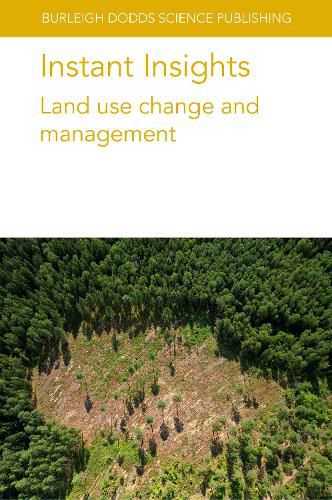Readings Newsletter
Become a Readings Member to make your shopping experience even easier.
Sign in or sign up for free!
You’re not far away from qualifying for FREE standard shipping within Australia
You’ve qualified for FREE standard shipping within Australia
The cart is loading…






This book features four peer-reviewed reviews on land use change and management.
The first chapter discusses the role of agricultural expansion, land cover and use change in contributing to climate change. It reviews the impacts of land-use change on climate, specifically focusing on carbon emission, surface energy fluxes and the emission of reactive gases from vegetation. The chapter also assesses how to estimate the impacts of land-use change on climate.
The second chapter provides an overview of human-induced land use changes, such as deforestation and intensive agriculture and their consequent impact on the agricultural ecosystem. The chapter focusses specifically on the ways in which land use alteration has impacted the composition and functionality of soil microbiomes within a Brazilian context.
The third chapter considers the range of publicly funded agri-environment schemes created by the UK government to mitigate the effects of climate change and reverse biodiversity decline. The chapter explores how these schemes have evolved alongside the principles of sustainable land management, as well as how they are shaped by the culture of the UK nations within which they develop.
The final chapter addresses the use of riparian forest buffers to link the land and aquatic environment at a landscape level. The chapter reviews the design and function of riparian forest buffers and filter strips as agroforestry practices and their role in performing vital ecological functions as part of the network of watersheds that connect forests, prairies, agricultural and urban lands.
$9.00 standard shipping within Australia
FREE standard shipping within Australia for orders over $100.00
Express & International shipping calculated at checkout
Stock availability can be subject to change without notice. We recommend calling the shop or contacting our online team to check availability of low stock items. Please see our Shopping Online page for more details.
This book features four peer-reviewed reviews on land use change and management.
The first chapter discusses the role of agricultural expansion, land cover and use change in contributing to climate change. It reviews the impacts of land-use change on climate, specifically focusing on carbon emission, surface energy fluxes and the emission of reactive gases from vegetation. The chapter also assesses how to estimate the impacts of land-use change on climate.
The second chapter provides an overview of human-induced land use changes, such as deforestation and intensive agriculture and their consequent impact on the agricultural ecosystem. The chapter focusses specifically on the ways in which land use alteration has impacted the composition and functionality of soil microbiomes within a Brazilian context.
The third chapter considers the range of publicly funded agri-environment schemes created by the UK government to mitigate the effects of climate change and reverse biodiversity decline. The chapter explores how these schemes have evolved alongside the principles of sustainable land management, as well as how they are shaped by the culture of the UK nations within which they develop.
The final chapter addresses the use of riparian forest buffers to link the land and aquatic environment at a landscape level. The chapter reviews the design and function of riparian forest buffers and filter strips as agroforestry practices and their role in performing vital ecological functions as part of the network of watersheds that connect forests, prairies, agricultural and urban lands.